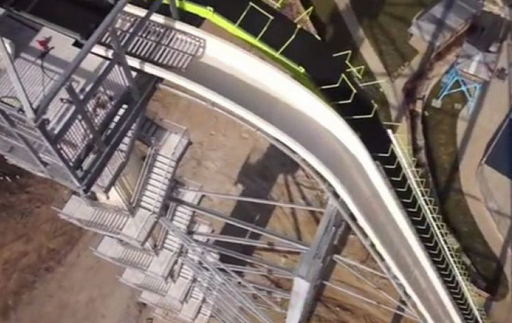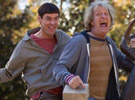

When Verrückt opens at Schlitterbahn Waterpark next month in Kansas City, Kan., it will stand taller than the Statue of Liberty from torch to toes, beating out the world’s current tallest water slide, Kilimanjaro in Barra Do Pirai, Brazil.
Intrepid riders of the Verrückt will hike up 264 steps and then plunge nearly straight down in four-person rafts and be propelled up and over a five-story hill.
Did I mention Verrückt means “insane” in German?
But Verrückt isn’t the only record-breaking, insane ride that has people’s hearts pounding. A slew of new attractions will open across the U.S. this summer that promise wild adventures fit for Guinness World Records.
At Busch Gardens in Tampa, Fla., Falcon’s Fury will tilt riders 90 degrees so they face the ground, then drop them more than 300 feet on what will be the tallest freestanding drop tower in North America.
Then there’s the world’s highest swing ride, opening at Six Flags Over Texas in Arlington; the world’s largest Ferris wheel, which recently opened on the Vegas Strip; and the Goliath, which will be the world’s fastest wooden roller coaster when it debuts this spring at Six Flags Great America in Gurnee, Ill.
All this reflects a rivalry among amusement parks to offer rides that are faster, bigger and higher-tech, says Jim Futtrell, historian for the National Amusement Park Historical Association.
“In an industry based on thrills and excitement, operators have always sought to push the envelope in terms of height or speed to stand out from the competition and keep their guests returning,” Futtrell says. “Over the past decade, however, we have seen an evolution.”
Beyond the record-breakers, many parks are pouring money into immersive experiences where visitors are part of the action, such as Harry Potter and the Forbidden Journey at Universal Orlando’s Islands of Adventure. When it opened in 2010, it was the first attraction to use robotic arms that move along a track and allow for twists and pivots galore. The Gringotts Bank ride, part of Universal’s Wizarding World of Harry Potter – Diagon Alley, set to open this summer in Orlando, will likely follow suit.
“Attractions such as Aquatica at Sea World (Orlando) and CarsLand at Disney's California Adventure (in Anaheim) have used cutting-edge technology to create completely immersive environments,” Futtrell says.
“You are seeing this spread to the regional theme parks, with Wonder Mountain Guardian opening at Canada's Wonderland (Ontario) this year. And other Cedar Fair parks are renovating entire areas to improve the environment.”
Cedar Fair, parent company of Cedar Point in Sandusky, Ohio, last year unveiled the Gatekeeper, a roller coaster that has the highest inversion or loop in the world. This season, Cedar Point will be adding two new rides to the Gemini Midway section of the park.
Theme parks of yesteryear
To truly appreciate the over-the-top experiences we have today, though, you first must take a walk down low-tech memory lane. The roots of the industry date back to Europe from 1550 to the 1700s, when pleasure gardens sprang up offering concerts, fireworks and even primitive rides on the outskirts of major cities. “As America started growing in the late 1800s and early 1900s, versions of these pleasure gardens began opening in American cities,” says Futtrell.
American amusement parks began as picnic grounds built by streetcar companies and local railroad and excursion boat operators.
“The amusement industry rode the wave of the industrial revolution in the late 19th century to lead the world,” Futtrell says.
The creation of the theme park was largely an evolutionary process in the years that followed World War II. This is when Ghost Town (which would later become Knott's Berry Farm) was developed in Buena Park, Calif.; Santa Claus Land was created in Indiana and Storytown in New York.
Then in 1955, Walt Disney opened Disneyland. Today, technology is “allowing Imagineers to bring their ideas to life,” says Duncan Dickson, who teaches theme-park management at the University of Central Florida. “There is an old story of John Hench having a model of Space Mountain on his desk for 10 years until the technology caught up and allowed them to build it.”
Now countries in Asia and the Middle East are also cashing in on the world’s love of thrills. China is building its own "Orlando of China” at Ocean Kingdom in Guangdong Province, where there are rides, attractions and the world’s largest aquarium.
Dubai is expanding Ferrari World Abu Dhabi, the world’s largest indoor theme park, and Yas Waterworld aqua park.
But “the USA is still on top, for no other reason than the sheer number of parks,” Dickson says. In fact, five of the 10 biggest theme-park companies in the world are based in the U.S.
“The other parks around the world do not threaten U.S. parks. They simply provide a quality theme-park experience for local and regional visitors,” Dickson says. “Most of the other parks are not destination parks, such as we have in Orlando. Their major visitor is a local or regional visitor, such as we see in Disneyland.”
At the end of the day, it is all about providing an experience that cannot be duplicated anywhere. Bigger, taller, faster, more immersive . . . that’s the experience that fits the bill.



















